My Avery Collection
The following narrative was original written in 2011 and was published in the book My Avery Needle Case Collection by Terry Meinke
in April 2012. Other than updating the chart and statistics indicating how many items are in her collection, no changes have been
made to this story other than dividing the text into sections to make it easier for individuals to access the information they are interested
in. The sections are:
Introduction
Stitching and Designs Samplers
Collecting Needlework Tools
eBay Auctions
Mann Collection Sale
Avery Statistics
Summary
Introduction
While preparing this photo book of my collection, I naturally began reminiscing about how I got here. Where did I get all of these wonderful pieces? How long had I been collecting them? And how did I start to collect Avery needle cases in the first place? So here it is - this is my story.
Stitching and Designing Samplers
I've always enjoyed crafts. When I was younger, I made several macramé candle holders, hooked a rug for my bedroom, crocheted teddy bears as Christmas presents, stitched a few petit point canvases of famous artwork (including the Mona Lisa), and even made a couple of miniature beaded Christmas trees. Then in late 1984, when Roberta and I visited the Lee Wards store in Schaumburg, Illinois, she saw a counted cross-stitch Christmas sampler and said "Terry, you should do that." I purchased the kit and within a few weeks the finished sampler was framed and hanging on the wall next to the Christmas tree. I liked stitching, but most of the kits I found at craft stores lacked imagination - for example geese with ribbons around their necks, or baby blankets. I also soon lost interest in stitching from kits. I wanted to create something special, something that no one else had thought of, something that would go with the country decor in my home, something that looked authentic, not modern.
It didn't take long before I found several companies that sold antique sampler reproduction kits so I purchased a few and stitched them from 1985-1987. Slowly I gained confidence to make a few little changes here and there with parts of the kits that I didn't especially like, leading to finished samplers that varied slightly from the original. A few years later, while visiting my local library, I found several books on antique samplers and decided to try to chart one I really liked from the small photograph in the book. I purchased some graph paper and quickly realized that designing provided me with just the challenge I was looking for. Of course, I had to use my imagination in many places because I just couldn't see exactly how many stitches made up each part of the design.
Around this time I discovered a software program for my PC called EZGRAPHER which gave me much more flexibility in designing. A computer programmer originally wrote this program for his wife to help her with her cross-stitch projects. Remember this was the late 1980s when most people didn't have personal computers, let alone software programs to use to design cross stitch charts. Back then I was fortunate because I worked for Honeywell Information Systems and was given one of their old PCs when the company upgraded their machines. I was also in the process of getting a Computer Science degree which came in handy for learning how software worked. Before getting the Honeywell PC, I did my COBOL homework on a Commodore 64 by dialing into Roosevelt University's mainframe computer! Most homes did not have this equipment nor did they have an interest in computers because PCs were still in their infancy. At that time the operating system had to be loaded first to the PC from a 5.5-inch floppy diskette, and then the EZGRAPHER program had to be loaded using another 5.5-inch diskette. Times really have changed since then and that was only about twenty-five years ago.
During those early years I had only one bad experience as a result of stitching. One day I left my canvas with needle and thread sitting on the sofa when I got up to go to the kitchen to get a drink of water. As I turned off the faucet and set down the empty glass, I looked up just in time to witness Waldi, my miniature dachshund, jumping up on the sofa and swallowing the needle and thread in one big gulp. Three hours and $500 later, my little dog returned home from the vet with a 4-inch scar and a few stitches of her own!
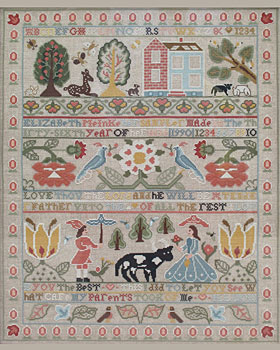
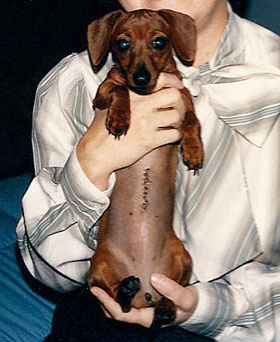
By 1988 I had developed some skill at designing so I entered one of my pieces in a cross-stitch competition at Rockome Gardens in Arcola, Illinois. Although the piece did not win the contest, the judges provided me with several comments that inspired me to continue. They indicated that not all of my stitches were crossed in the same way and that sometimes I carried a piece of thread too far across the back when stitching from one section to the next. I didn't even know all of the stitches were supposed to be crossed in the same direction since I had never read any instructions on how to cross stitch! A few months later I took a couple of stitching classes, and the next year I won best original design, and the year after, best in show. I purchased all the books I could find that contained antique samplers and traveled to Baltimore, Maryland, to see an exhibition of the collection of Betty Ring. I even wrote Betty a letter to show her a design I created from a sampler in a book documenting her collection. In 1990 while in the Boston area on business, I spent the weekend in New England and visited the Rhode Island School of Design where the curator brought out several of their best samplers so I could have a special viewing. I continued to enter contests and won more awards, including one sponsored by Good Housekeeping magazine. In the March 1990 issue, the magazine announced their contest which was to find the best modern samplers in the country that reflected literacy in their design. This was being done to support The Foundation for Family Literacy which was organized by First Lady Barbara Bush. My entry entitled "The School House Sampler" included an eagle with American flags, the alphabet (both upper and lower case), an old poem about school, and a young girl sitting in front of an old-fashioned one-room school house reading a book. It was one of only three completely original designs that I ever made. I designed it shortly after learning about the contest, and all stitching was completed by July 1990. "The School House Sampler" won first prize in the “original design category,” and I was rewarded with a trip for two to Colonial Williamsburg. When the contest winners were announced, the sampler was pictured in the magazine's March 1991 issue, where it was also sold as a kit. Needless to say designing and stitching had become my passion.
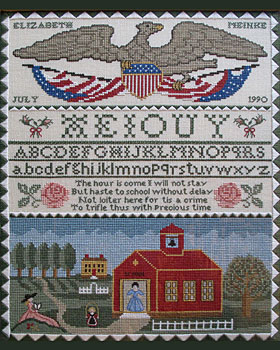
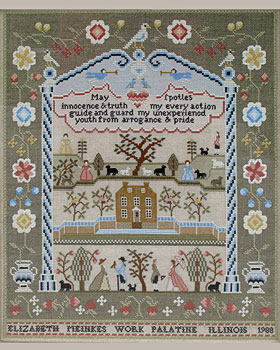
Around 1991 I was approached by the owner of The Scarlet Letter, a company in Wisconsin that specialized in antique sampler reproductions. I was ecstatic to hear they wanted me to design samplers for them. The owner had permission from several museums, including the Fitzwilliam in Cambridge, England, to chart major pieces in their collections. I was given larger-than-life- sized photographs of the original samplers to use as a guide and as a result spent my spare time during the next two years charting and stitching some of the world's most famous samplers. I used the money earned charting to purchase antique needlework samplers which The Scarlet Letter also sold. My first and only purchase was a quite expensive 18th century English cutwork sampler.
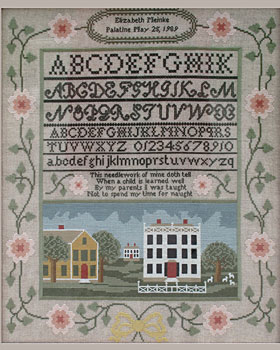
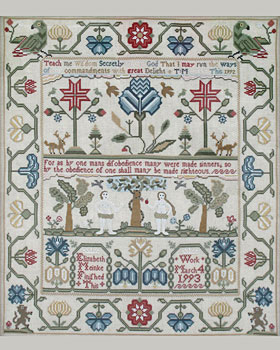
Collecting Needlework Tools
Around this time I read an article in one of my needlework magazines about Victorian Brass needle cases and other needlework tools: other types of needle cases, thimbles, tape measures, etc. Some pieces were photographed in the magazine and I couldn't help but like the one that looked like a real butterfly. It was so cute! What a surprise I had on Christmas Day in 1992 when I opened a gift from my mother - my first Avery, the Butterfly – amazing despite the fact it had lost its original antennae! (I later replaced it with another that had all original parts.) The gift was especially fitting, given that my mother is an antique dealer who specializes in copper, and the needle case was made of brass, an alloy of copper and zinc. Within days I decided to start collecting needlework tools instead of original samplers, because they were more reasonably priced. At least that is what I thought at the time. I never imagined the price I would one day pay for a tiny needle case!
In early 1993, I discussed this change in my collecting goals with Marsha at The Scarlet Letter, and she forwarded a brochure to me from Christie's in London where she purchased many of her samplers. In April Christie’s was selling the collection of Estelle Horowitz at auction. Through Marsha I bid on several items and won a couple of pin cushions, but no Averys. Later that same year, however, I purchased the Temple Bar needle case from a dealer at an antique show. The Temple Bar had the same G. R & Co trademark and a tiny, unusual, dent in one side that made it look very much like the one photographed and described in the Christie's catalog. As a result, I think I have at least one Avery that once was part of Estelle's collection.

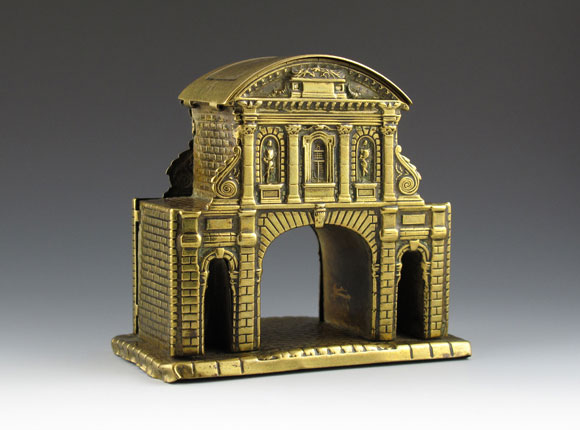
Sometime in 1993 I decided to stop charting for The Scarlet Letter as I no longer was able to pick the samplers I wanted to chart and I had lost my passion for designing samplers. I must have stopped stitching around that same time, for all of the samplers in my house have dates between 1987 and 1993 except for the one I stitched eight years later in 2001 just to prove I could still do it. To this day a partially stitched Scottish sampler reproduction that I charted for Marsha sits on a shelf way back in my closet, still attached to its original working frame. By 1994 genealogical research had caught my fancy, followed by photography and, more recently, creating Shutterfly photo books. Just when I realized I couldn't complete that Scottish sampler, I began doing research on my Scottish ancestors. That sampler, which represented the end of one phase of my life, had led me to my ancestors. Something was telling me I had unfinished business to do with Scotland. In August 1994 I spent a month in Scotland visiting all of the places from which my Scottish ancestors came. Around the same time I stopped collecting needlework tools in general and decided to focus solely on Avery needle cases.
At first I made all of my purchases at antique shows. Twice a year I went to the O'Hare Expo Center Antique Show in Rosemont and the Pheasant Run Antique Show in Wheaton or the Arlington Park Antique Show in Arlington Heights, shows in Illinois frequented by dealers who sold Averys. By the late 1990s, however, it became harder and harder to find Averys at shows so I started to bid on them through eBay. My first purchase on eBay was in 1999, and by 2001 I was buying almost exclusively through eBay.
eBay Auctions
At first the excitement of bidding on eBay was a lot of fun. If you bid too early you just bid the price up unnecessarily and if you bid too late or your PC response time lagged, your bid would fail to get placed. There was always the possibility that you wouldn't win an auction because of a system glitch, which happened to me a number of times especially during those early years when I accessed the Internet through a dial-up connection. Another thing that made auctions so interesting back then was that each bidder had their own unique name, therefore you got to know your major competitors through their characteristic bidding behavior. My eBay name was "meinket" and my biggest competitors were "mopsyfan" and "inesq". I can't tell you how many times they outbid me. However, I'm sure others like "imspendn" and "ulala" felt that way about me because I usually outbid them! Sometimes, I'd lose an auction the first time the item appeared, only to win the same piece a few years later when another one came up for auction. During the years there were only three Avery auctions I lost that never came up again. In retrospect, I wish I had bid more on them: Beehive, Guitar, and Star. Within the next couple of years I discovered EZSNIPE which, for a small fee, allows a third party to place a bid for you i n the last seconds of an auction. Through this method you can ensure that you don't lose auctions in the last few seconds because of a computer glitch. Around the same time, eBay discontinued displaying bidder names on the bid history because they could not guarantee the names would not be used in a fraudulent manner. Today, bidding on eBay is not quite as much fun.
My most exciting auction occurred in May 2003. Roberta and I were on vacation in Yellowstone National Park. On our last night we stayed at the Holiday Inn in Bozeman, Montana where we had our first opportunity to access the Internet in two weeks. After checking my email, I searched eBay for Averys and an auction popped up with the Eiffel Tower Needle Case. I had never before seen this needle case nor was it mentioned in Ruth Mann’s book. Since the Eiffel Tower was constructed for the 1889 World's Fair I was concerned about the authenticity of the piece. I didn't think they manufactured many Averys after 1880. Five years of eBay experience had taught me that forgeries were out there, although I'd never seen any concerning needle cases. Nevertheless, because unusual Averys often sold for over $1,000, a forgery would hardly be unexpected. Was this really an Avery? The photos on the auction listing were so bad it looked as if someone had taken a small drawer with the W. Avery & Son trademark on it and inserted it into the base of a cheap Eiffel Tower statue. The auction text warned that there would be no returns and not to bid if you weren't sure. When I got home I emailed the seller a few days before the auction was due to end and asked a couple of questions about the piece, asking if she could send me another photo of the bottom of the needle case. I wanted to place a large bid, but had to be certain the piece was a real Avery. Unfortunately, the seller never replied and I did not place the bid and neither did my usual competitors. We must have all doubted its authenticity. It sold for only $287, almost 9 times less than what I would have bid. The day after the auction closed, another Eiffel Tower Avery was posted for sale on eBay by another seller. I requested the same information as I had for the first one, and this time, after receiving additional photos and answers to all of my questions, I felt confident of its authenticity. I bid $2,500 and won the auction for slightly less than that. To date, although it is not the most I ever bid on an Avery, it is the second most I ever paid for an Avery.
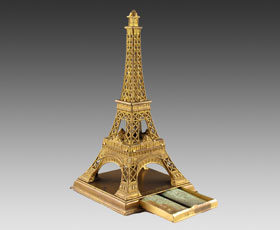
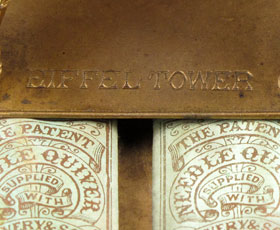
Mann Collection Sale
By mid-2005 my Avery collection had expanded to 68 pieces, and it became difficult to find pieces that I didn't already own. I had just purchased the Arc de Triomphe from Pat Mizrahi at the summer O'Hare Antique Show when the most amazing thing happened. Bunnyplace, an eBay seller from whom I had purchased a couple of items over the years, obtained the collection of Ruth Mann and decided to sell several pieces each week over a six-month period. This would be the opportunity of a lifetime! From September 2005 through March 2006, one fantastic piece after another appeared on eBay. As a result, I was able to purchase many of the nicest pieces in my collection. At first I didn't think I'd be able to afford them because I had just spent $1,800 on the Arc de Triomphe and, at those prices, could only afford to purchase one or two pieces a year. Therefore, in order to fund my expenditures, I decided to sell anything and everything I could on eBay myself. All of the things I had accumulated over the years that I didn't really enjoy much anymore went straight to eBay. I even sold my Greek antiquities that I collected when I first moved to Chicago (except one) which had been in a box in the garage for the last 25 years. I needed the cash as I knew I would probably never see these Averys again. As a result, I earned $6,039 and added the following items to my collection: Bird Nest, Windmill, Golden Cart, Diamond Jubilee Lap Desk, Shield with Rose, Rose Pin Case and Scott's Bust Oval Tub. And when I finally ran out of money, Mom bid on and won The Cradle for me. Later, I learned that the Arc de Triomphe I had purchased earlier from Mizrahi had also come from Ruth's collection.
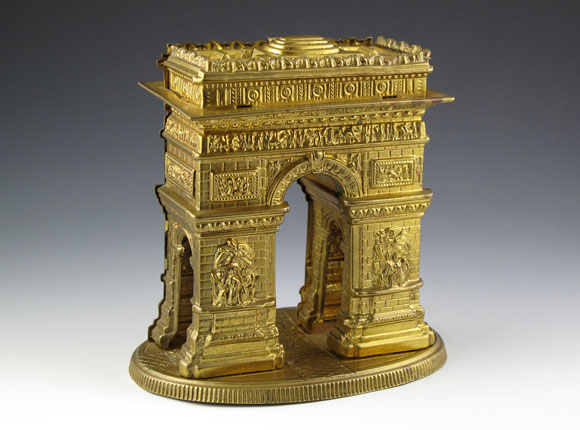
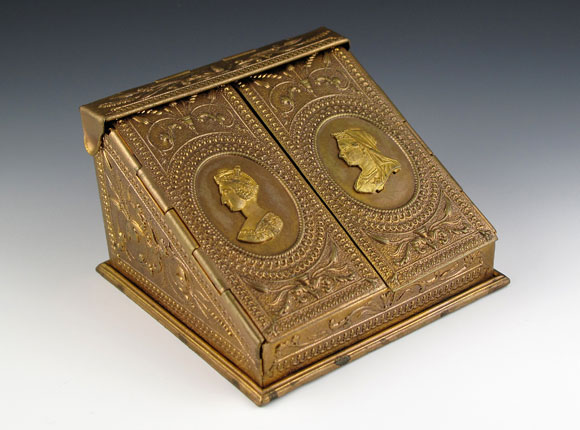
Avery Statistics
Figural needle cases come in many different sizes and shapes, with each overall design making a piece unique. Although flat needle cases do not vary much in shape, three components give them appealing: 1) interesting patterns pressed or inscribed onto the brass; 2) unusual mechanics that enable the needle case to dispense needle packets; and 3) the variety of company names that appear on the cases.
During the past 29 years, I’ve seen a number of different manufacturer names on the needle cases for sale at antique shops or posted on eBay. I never limited myself to collecting only needle cases with the Avery name inscribed on them. I purchased whatever was available for sale that I didn’t already own. In the last couple of years, however, I have made an attempt to purchase cases that had a company name other than W. Avery & Son in order to see how many different names I could find. Most of the variety in names seems to be in the flat needle cases. Of the 208 pieces in my collection, 45% contain the W. Avery & Son name. Of the 93 figural cases, 65, or 70%, contain W. Avery & Son. The fact that 70% of my figural needle cases have Avery inscribed on them cannot be purely chance. This evidence along with the patent history that Ruth Mann presented in “Victorian Brass Needlecases” and references to the company in 19th century publications indicate that Mr. Avery was the point of origin for figural brass needle cases and, as a result, was the largest producer of that type of case. Although there were many needle manufacturers in Redditch, Mr. Avery most likely created figural needle cases as a way to promote the sale of his needles. According to Redditch history, the area’s manufacturers used many schemes in the 19th century to improve production and promote the sale of needles, the product for which Redditch was world renowned!
The breakdown of my collection is as follows:
Company |
Total |
Non-Figural |
Figural |
Asser & Sherwin - London |
1 |
1 |
0 |
W. Avery & Son - Redditch |
93 |
28 |
65 |
Baggallays, Westall & Spence - London |
3 |
1 |
2 |
W. Bartleet & Sons - Redditch |
2 |
1 |
1 |
C. S. & Co - London |
1 |
1 |
0 |
Charles, Reynolds & Co - Cheapside, London |
1 |
0 |
1 |
Cocheran, Mclean & Co - New York |
1 |
1 |
0 |
Cook - Son & Co - London |
7 |
6 |
1 |
Copestake, Moore, Crampton & Co - London |
5 |
5 |
0 |
Cormack BROs - London |
2 |
0 |
2 |
Edward Cox - Westbouren Grove, London |
1 |
1 |
0 |
Ellis, Howell & Co - London |
1 |
1 |
0 |
John English & Co - Feckenham |
1 |
0 |
1 |
D. H. Evans & Co Ld - London |
1 |
1 |
0 |
Fisher - 188 Strand, London |
1 |
0 |
1 |
G. C. H & Co - Birmingham |
2 |
2 |
0 |
G. R & Co - origin unknown |
1 |
0 |
1 |
Gay & Son - London |
1 |
1 |
0 |
W. Hall & Co - Studley |
4 |
1 |
3 |
Thomas Harper - Redditch |
1 |
1 |
0 |
Hayes Crossley & Son - Alcester & London |
1 |
1 |
0 |
T. & J. Holyoake, Redditch |
1 |
1 |
0 |
Hutton & Co - London |
4 |
4 |
0 |
Arthur James - Redditch |
1 |
1 |
0 |
T. Johnson & Sons - Redditch |
2 |
2 |
0 |
G. H. Johnstone - Birmingham |
2 |
2 |
0 |
C. Laight & Sons - Redditch |
1 |
1 |
0 |
E. Luke - Brixton, London |
1 |
1 |
0 |
Mappin Bros. - London |
2 |
1 |
1 |
Melliship & Harris - London |
1 |
1 |
0 |
H. Milward & Sons - Redditch |
10 |
8 |
2 |
R. Moffat & Co - New York |
1 |
1 |
0 |
Abel Morralls - Redditch, Studley & London |
2 |
2 |
0 |
C. & J. Morton - London |
1 |
1 |
0 |
D. Nicholson & Co - London |
1 |
1 |
0 |
Perry & Co - London |
4 |
4 |
0 |
Pratt & Farmer - New York |
5 |
4 |
1 |
R. J. Roberts - New York |
1 |
1 |
0 |
Sydney J. Saunders - London |
1 |
0 |
1 |
Thomas Savage - London |
1 |
1 |
0 |
Charles Schleicher - Belle-Vallee (Aachen, Germany) |
1 |
1 |
0 |
Seaman, Little & Co - Kensington |
1 |
0 |
1 |
Albert Sharpe - London |
1 |
1 |
0 |
Jas. Smith & Son - Astwood Bank |
1 |
1 |
0 |
Stacy - London |
1 |
1 |
0 |
J. W. Stutter - London |
1 |
1 |
0 |
S. Thomas & Sons - Redditch |
1 |
0 |
1 |
G. Townsend & Co - Hunts End, Redditch |
2 |
1 |
1 |
R. Turner & Co - Redditch |
1 |
1 |
0 |
Unmarked |
20 |
14 |
6 |
Vyse, Son & Co - London |
1 |
1 |
0 |
C. G. Wacker - Redditch |
1 |
0 |
1 |
W. Whiteley - Westbourne Grove, London |
1 |
1 |
0 |
W. Woodfield & Sons - Redditch |
1 |
1 |
0 |
R. Wyers - Redditch |
1 |
1 |
0 |
Totals |
208 |
115 |
93 |
Summary
In February 2011, while preparing my first book, I had the pleasure of adding the Hygrometer Weather House needle case to my collection. This is a fabulous piece, one of the top five in my collection and the needle case that cost me the most, to date. One thing that makes it special for me is the tiny fox weathervane on the building’s roof. It reminds me of the branch of my family that came from the Ostfriesland area of northwestern Germany. Due to its proximity to Holland, the area had many windmills, each with a small fox weathervane. According to German legend, the fox guards the windmill against fire. The surname of my ancestors, Voss, is a derivative of the word “fox” in German which could mean my ancestors were the ones who guarded the windmills!
The Hygrometer Weather House was one of the last pieces from Ruth Mann’s collection sold on eBay by Bunnyplace. No company name is inscribed on it, however, according to Ruth’s book; the patent for this item was registered to Coggins & Baxter of Birmingham. The Birmingham postal directories for 1878 and 1879 indicate they were jewelers. This company also designed the Windmill needle case, and although the patent for the Windmill was assigned to Coggins & Baxter, the W. Avery & Son name is engraved on the back. Mr. Avery apparently contracted with the Birmingham jeweler to create this case. To me, fine jewelry is almost like art. As Betty Ring, a collector of antique samplers, once wrote to me: To her, each of the samplers in her collection was like a little work of art. This is exactly how I feel about my Avery needle cases. Each is a miniature work of art!
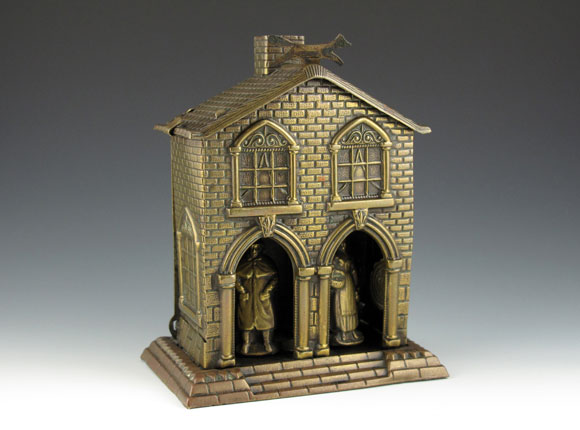
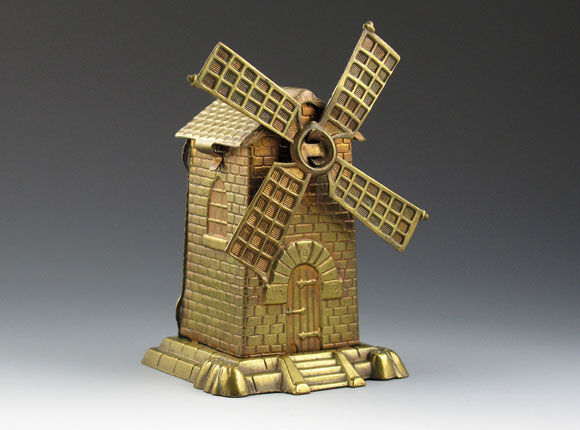
Before I end let me say that in honor of my collection I named my Shetland sheepdog puppy “Avery” when I adopted him in 2008. Now the word “Avery” is in daily use in my house and not just when I'm peering into the Howard Miller case where my Averys are displayed in my living room! Also in honor of several of my favorites, I climbed the 674 steps to the second level of the Eiffel Tower and the 284 up to the roof of the Arc de Triomphe during my 2009 vacation to Paris with my mother and Roberta. Now in addition to having two great pieces in my collection, I recall that wonderful vacation every time I look at my collection.
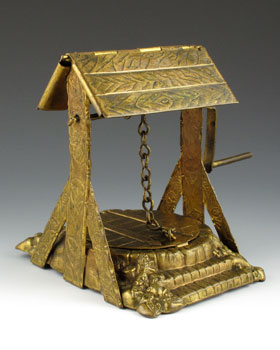
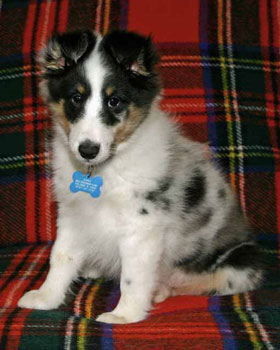
I am frequently asked which one is my favorite needle case. It is really hard for me to pick a favorite Avery as each one possesses something unique that makes it special. The Eiffel Tower comes first, because of the story of how I purchased it, its amazing detail, and the memories of my trip to Paris. Cock Robin's Grave must come second. The Butterfly is special because it was the first and it came from Mom. The Windmill and the Hygrometer Weather House are special because they remind me of my German ancestors from Ostfriesland. The Wishing Well is special because the first wishing well I received my brother Drake found at a flea market in France or Germany, and I really do believe that if you wish hard enough, dreams come true. Otherwise, how would I ever have found all of these wonderful Averys!




